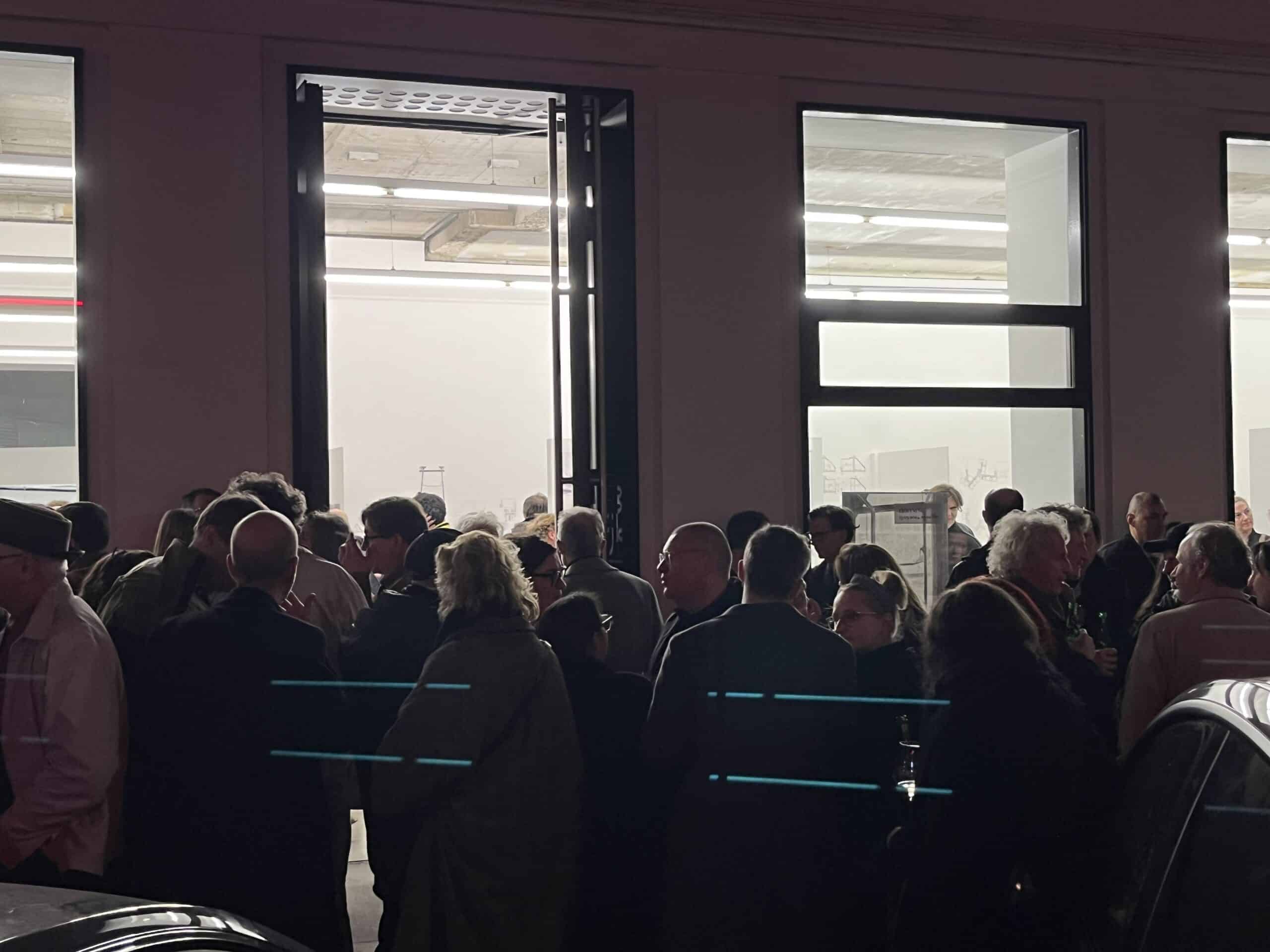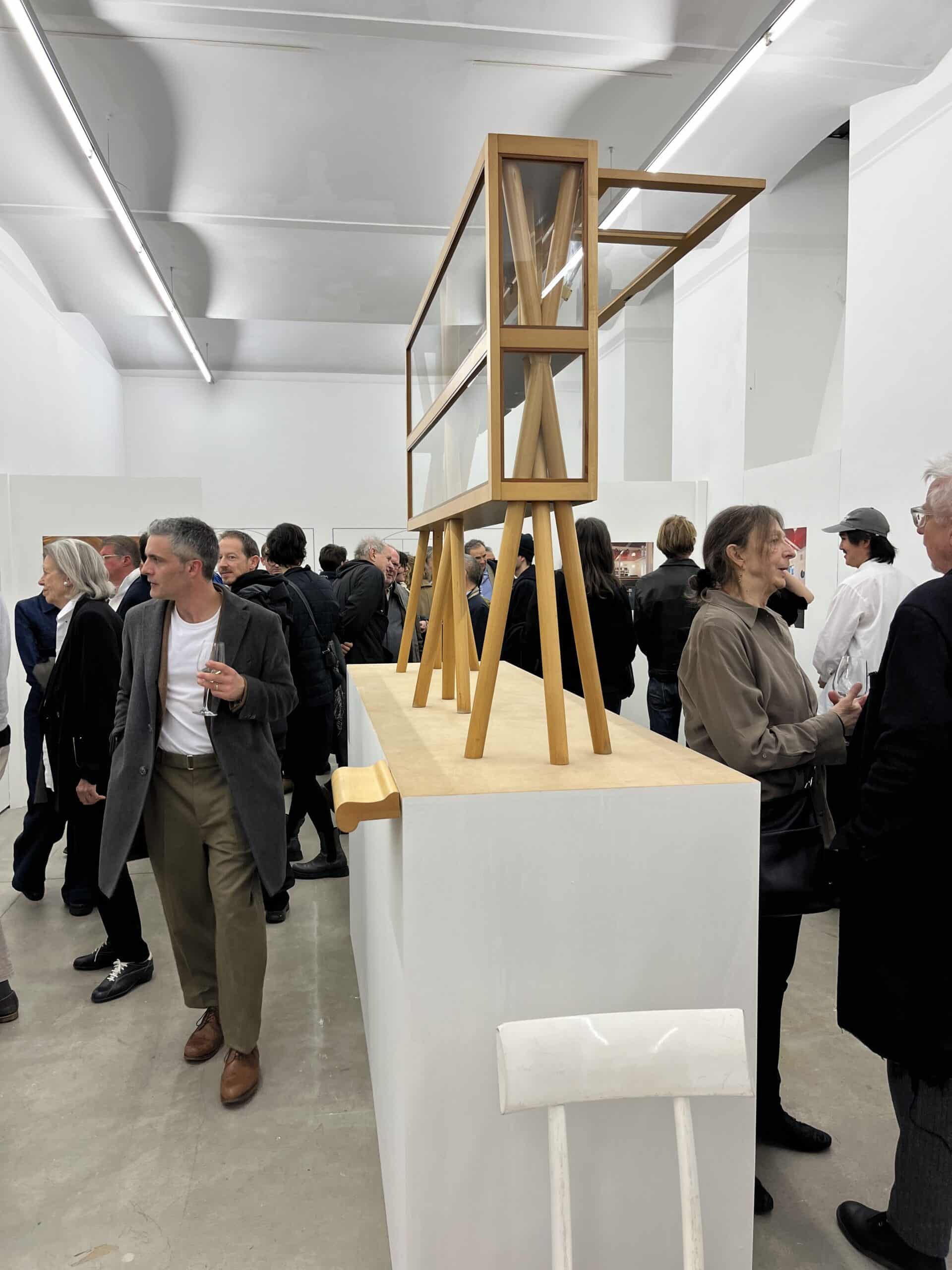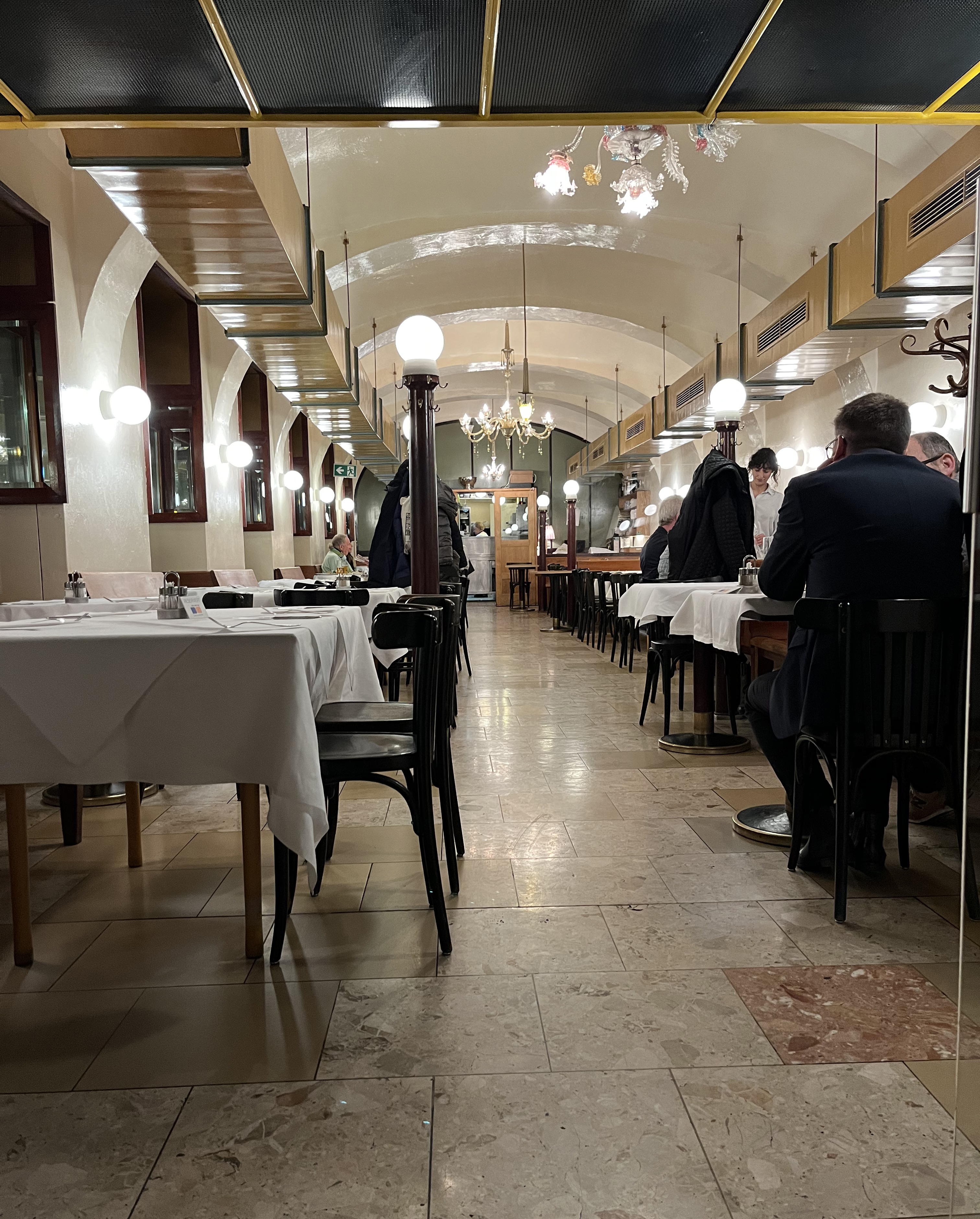Hermann Czech: Approximate Line of Action
Hermann Czech: Ungefähre Hauptrichtung (Approximate Line of Action) is on show at Fanz-Josef-Kai 3, Vienna, from 16 March – 9 June, 2024.
On 15 March 2024, an exhibition on the Austrian architect Hermann Czech’s work opened in Vienna at the exhibition space Franz-Josefs-Kai 3 (fJk3). It is the first retrospective exhibition of his work, spanning Czech’s entire career, and is curated by Claudia Cavallar, Gabrielle Kaiser, Eva Kuss, and Fiona Liewehr in cooperation with the architect himself. 500 visitors were expected for the opening, but more than 1000 people showed up. At the dinner later the same evening at Restaurant Salzamt, which Czech designed in 1983, he was greeted with a standing ovation.

Born in Vienna in 1936, Czech has for a long time been considered ‘an architect’s architect’. He is still not so well known outside Vienna, but slowly this is changing and Czech is beginning to get the wider recognition he deserves. As early as 1985, Wilfried Wang published Restaurant Salzamt in the legendary 9H magazine and two years later staged a small exhibition at 9H Gallery accompanied by a booklet titled ‘Options in Architecture’—which contains one of the best texts on Hermann Czech to date, written by Otto Kapfinger. More recently, the Japanese magazine A+U devoted a monograph issue to his work (2016), and Park Books has published an extensive monograph (2018)—based on architect Eva Kuss’s dissertation on Czech—and a collection of Czech’s writings in English translation (2019).[1]
From the 1970s, Hermann Czech became the protagonist of a new wave of ‘quiet’ architecture, a refined mannerism that draws nourishment from both Adolf Loos and Josef Frank. Central themes in his work include the idea of architecture as background, Umbau (modification), heterogeneity, and comfort (both its loss and how to obtain it). Perhaps parodying Hans Hollein, for whom Czech worked from 1974 to 1980, Czech has stated that ‘Alles ist Umbau’, meaning all projects relate to something existing. He also works with a kind of objectivity, treating each question or function with its own logic, resulting in heterogeneous design solutions.


The exhibition at fJk3 includes a wide range of projects, from urban plans and apartment buildings to interiors, furniture, and fittings. There are models of House M (1977–81) and House S (1980–83) and the frame for the T-shaped small apartment buildings where the users themselves were involved in the layout of the rooms in their various apartments. In the exhibition there are some sketches like the one for the glazed roof over Graben which I have seen reproduced many times but never in real. The many pieces of furniture include a thin three-legged vitrine, Thonet chairs, and a fixed U-shaped leather sofa from the MAK Café; and the Josef Hoffmann chair that was appropriated for one of Czech’s first projects in the early 1960s which was an interior design for his own father’s restaurant. There are also two crystal chandeliers on poles from Palais Schwarzenberg and much more.
One of Czech’s specialities is stairs—a complex architectural task, requiring a lot of experience and quiet knowledge. In the gallery, Czech has made a mock-up of a wooden stair from the basement to the entrance level which is only 50cm wide. The stair swings in two 180-degree turns. When I ask him how he dared to make such a narrow staircase, he replies that he remembered a staircase in Rome that was only 45 cm and worked perfectly well!
* * *

It is unusual for an architecture exhibition to have several of the projects on display within walking distance and possible to visit and there is a foldable map produced for the exhibition to guide visitors around the city. Kleines Café (1970–74) at Franziskanerplatz and Gasthaus Pöschel (2000) around the corner are just a 10-minute walk away. At the top of the building across the street from the Kleines Café side entrance is Czech’s office with its book-filled vitrines. Wunderbar (1976) is also nearby.
On the way to the opening, I passed by the antiquarian bookshop Löcker & Wögenstein which Czech designed during the 1970s. On the facade of the shop small vitrines display books; a drain pipe goes through the wood-clad corner of one of the vitrines. I first saw them thirty years ago on my way to a meeting with the architect Johannes Spalt (1920–2010) who lived and had his studio across the street. Spalt had a remarkable collection of books and furniture including Adolf Loos’ foldable English writing desk. In 1981 Czech and Spalt staged a ground-breaking exhibition on Josef Frank in Vienna.
Herr Löcker lets me come all the way through the labyrinth-like store to the glazed courtyard at the back, ending in the small lunch room behind a bookcase. Czech’s book tables and display cabinets are hidden behind new stacks of books since I was there last time. On the way out, I stop at the irregular floor tiles in the entrance room. They caused a lot of irritation with the builder, Herr Löcker tells me with a smile. The floor pattern is on the cover of Eva Kuss’s monograph. Because the floor tiles are not completely square—they are 50 x 51 cm—a calculated bias arises in the division. In 1958, Josef Frank wrote in his manifesto Accidentism: ‘we should design our surroundings as if they had originated by chance. Every place in which one feels comfortable—rooms, streets, and cities has originated by chance.’ ‘As if they had originated by chance’ indicates that ‘Accidentism’ is not the same thing as letting chance have free rein, but it is an intellectual strategy.

* * *
Across the city, Czech has designed a handful of restaurants and cafés, each with a distinctive atmosphere and obvious everyday charm. In Czech’s interiors, the whole consists of different parts without requirements for conformity. The architecture is multi-layered and does not make itself known at a quick glance.
One of Czech’s most refined interiors is that of Restaurant Salzamt, a short walk from fJk3. You enter it from the street through a narrow door into the bar. The red-painted bar itself has an elliptical form relating it in a subtle way to Vienna’s baroque heritage. The odd-looking front legs of the vitrines above the bar counter are replicas of the legs of vitrines Josef Frank designed for the Museum of East Asian Art in Cologne. I learned from Czech that the complicated-looking form derives from two simple cuts done diagonally, giving the legs their special curvature. The fixed sofa in the bar, of the same type as in Kleines Café, has a profile resembling the seating in old carriages. It is clad in leather and the buttons make concave surfaces beside the convex ones. You have to be able to change your sitting position since you only sit comfortably in the same position for 15 minutes. The traditional upholstery, an almost forgotten craft, also relates to the ergonomic studies that Edmond Grandjean and others had developed in the 1960s.


In the dining room at Salzamt, fixed wooden benches run along the walls in the long vaulted room, together with small tables and bentwood chairs. The lighting is standard opal glass light fixtures on poles that also function as coat hangers. Subtle details bind together elements of the restaurant’s interior in a gentle way: two air ducts hanging from the ceiling are curved, making a larger distance in the centre of the room, articulating it; the floor slopes slightly towards the centre from both sides of the room; and the light-yellow colour on the walls adds to the special atmosphere of the restaurant.
Not far from the exhibition on Ringstrasse is the MAK’s large museum building, which housed one of Hermann Czech’s most striking interiors: the MAK Café. By a happy coincidence, I was in Vienna in 1993 with a colleague working on research for a Josef Frank exhibition in Stockholm when we were invited by Czech to the opening. The Café was part of the museum’s director Peter Noever’s remodelling of the entirety of the MAK where he invited artists to design and curate different halls. MAK Café was a beautiful, light-filled, generous, and inclusive room. Czech’s interior is sadly been gone for a long time, but the Thonet chairs he designed for the project are still in production, with their slightly reclined seating position and paintwork that makes them look like they are wearing trousers that are too short. Even in Vienna interiors are fragile and easily disappear—in the list of Czech’s projects, many are marked ‘zerstört’ (destroyed).

At an age when most people have retired, Hermann Czech continues to produce. The exhibition includes a number of recently realised projects, such as a small hotel in Zell am See (2018) or the recently opened Sigmund Freud Museum at the legendary address Berggasse 19 (2020). Czech also participated in the latest Venice Architecture Biennale with the young architect collective AKT. It is wonderful that this rich collection of Czech’s wide-ranging career has finally become the subject of a comprehensive exhibition. Due to limited space, the curators have been forced to a strict selection, but the combination of furniture and objects gives the exhibition a sharpness and authenticity. I hope that the precise texts that are on the walls describing all the projects in the exhibition will be collected into a publication with extensive image material of well-known and less well-known projects.
Notes
- Eva Kuss, Hermann Czech: Architekt in Wien, (Zürich: Park Books, 2018) and Hermann Czech: An Architect in Vienna , second edition, (Zürich: Park Books, 2023).
Mikael Bergquist is an architect and educator. He runs his own office in Stockholm and a Master studio at KTH. MB have written several books on Josef Frank and have renovated two of Josef Frank’s summer villas in Falsterbo. Forthcoming from Park Books is the book: Center and Periphery: Five houses by Mikael Bergquist which collects some of MBs small wooden houses in the Swedish countryside.
This Friday, 10 May, Hermann Czech will be guest at The Architecture Foundation’s Architecture on Stage series at the Barbican. For more information click here.

– Lars Lerup